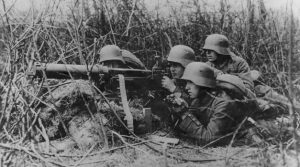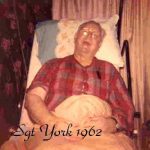 Recently, I found out that my family is related to Alvin Cullum York, who was one of the most decorated United States Army soldiers of World War I. York is my 8th cousin once removed on my dad’s side of the family. York received the Medal of Honor for leading an attack on a German machine gun nest, taking 35 machine guns, killing at least 25 enemy soldiers, and capturing 132. York’s Medal of Honor action occurred during the portion of the Meuse-Argonne Offensive in France, which was led by the United States, and was intended to breach the Hindenburg line and force the Germans to surrender.
Recently, I found out that my family is related to Alvin Cullum York, who was one of the most decorated United States Army soldiers of World War I. York is my 8th cousin once removed on my dad’s side of the family. York received the Medal of Honor for leading an attack on a German machine gun nest, taking 35 machine guns, killing at least 25 enemy soldiers, and capturing 132. York’s Medal of Honor action occurred during the portion of the Meuse-Argonne Offensive in France, which was led by the United States, and was intended to breach the Hindenburg line and force the Germans to surrender.
York was born in rural Tennessee on December 13, 1887, the third of eleven children of William and Mary (Brooks) York. His parents farmed, and his father worked as a blacksmith. The York children had minimal schooling because they helped provide for the family, which included hunting, fishing, and hiring out as laborers. After the death of York’s father, he assisted in caring for his younger siblings, and found work as a logger and on construction crews. York wen to church on a regular basis, but he also drank heavily and had a reputation for fistfighting. In 1914 he had a conversion experience, and vowed to improve. He became even more devoted to the Church of Christ in Christian Union.
Upon being drafted into World War I, York initially claimed conscientious objector status on the grounds that his denomination forbade violence. It was because of his internal struggle about whether or not war was the same  as murder. York prayed about it for the better part of a whole night, before feeling led to proceed with his military assignment. York joined the 82nd Division as an infantry private, and went to France in 1918. He was a part of the group of soldiers know as dough boys. In October 1918, York was promoted to corporal, as one of a group of 17 soldiers assigned to infiltrate German lines and silence a machine gun position. After the American patrol had captured a large group of enemy soldiers, German small arms fire killed six Americans and wounded three. York was the highest ranking of those still able to fight, so he took charge. While his men guarded the prisoners, York attacked the machine gun position, dispatching several German soldiers with his rifle. By the time six Germans charged him with bayonets he was out of rifle ammunition, so he drew his pistol and shot them all. The German officer responsible for the machine gun position had emptied his pistol while firing at York, but missed. This officer then offered to surrender, and York accepted. York and his men marched back to their unit’s command post with more than 130 prisoners. York was immediately promoted to sergeant, and was awarded the Distinguished Service Cross. After further investigation the award was upgraded to the Medal of Honor. York became a national hero and international celebrity. He also received decorations from several foreign countries, including France, Italy, and Montenegro.
as murder. York prayed about it for the better part of a whole night, before feeling led to proceed with his military assignment. York joined the 82nd Division as an infantry private, and went to France in 1918. He was a part of the group of soldiers know as dough boys. In October 1918, York was promoted to corporal, as one of a group of 17 soldiers assigned to infiltrate German lines and silence a machine gun position. After the American patrol had captured a large group of enemy soldiers, German small arms fire killed six Americans and wounded three. York was the highest ranking of those still able to fight, so he took charge. While his men guarded the prisoners, York attacked the machine gun position, dispatching several German soldiers with his rifle. By the time six Germans charged him with bayonets he was out of rifle ammunition, so he drew his pistol and shot them all. The German officer responsible for the machine gun position had emptied his pistol while firing at York, but missed. This officer then offered to surrender, and York accepted. York and his men marched back to their unit’s command post with more than 130 prisoners. York was immediately promoted to sergeant, and was awarded the Distinguished Service Cross. After further investigation the award was upgraded to the Medal of Honor. York became a national hero and international celebrity. He also received decorations from several foreign countries, including France, Italy, and Montenegro.

To reward their hero, some businessmen in Tennessee organized the purchase of a farm for York, his new wife, and their growing family. York later formed a charitable foundation to improve educational opportunities for children in rural Tennessee, as a way of giving back o his home state. In the 1930s and 1940s, York worked as a project superintendent for the Civilian Conservation Corps and managed construction of the Byrd Lake reservoir at Cumberland Mountain State Park, after which he served for several years as park superintendent. In his later years, York was confined to bed by health problems. He died in Nashville, Tennessee, on September 2, 1964 and was buried at Wolf River Cemetery in his hometown of Pall Mall.


Leave a Reply